What is a brooder?
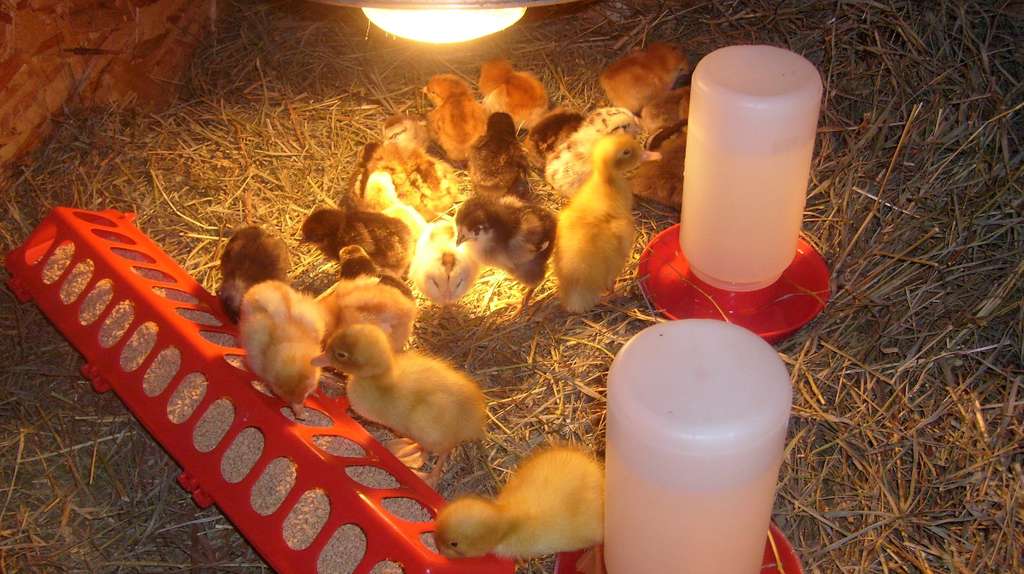
A brooder is a self-contained area that provides a warm and safe environment for chicks. The extra warmth is supplied by a heat lamp or electric hen like the one keeping these chicks warm below.
Table of Contents
- What does "brood" mean?
- What equipment goes in a brooder?
- What is a brooder used for?
- Where should you put a brooder?
- How long should chicks be kept in a brooder?
- How do you make a brooder?
- How big should a brooder be?
- Brooder precautions:
- Which is the best bedding for the brooder floor?
- How do you heat chick brooders?
- How do you set up a brooder?
- Food for baby chicks in the brooder:
- Can you brood chicks outside?
Below: A more up-to-date option is the electric panel, which consists of a heated plate on legs.
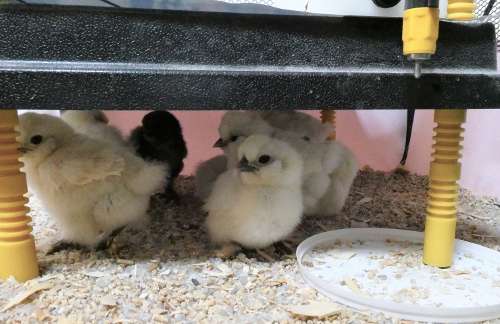
The chicks go under this for warmth, as they would with a hen, some even have a shroud around the edges to mimic the hens feathers.
Below: Here are some chicks sleeping happily under a red light in a brooder.
If you’ve ordered some day-old chicks or are going to fetch very young stock, they will need a brooder waiting for them and it needs to have been running properly for a day or so to make sure everything is working properly. Even if you use a broody hen for hatching, it’s a good idea to be aware of what is required for artificial brooding in case of emergencies.
What does "brood" mean?
The word "Brood" is often how poultry keepers refer to a batch of chicks and a "brooder" is the enclosure where chicks are kept warm and safe for the first 6 weeks of their life.
The brooding area or brooder, which provides protection during the first six weeks needs to be prepared in advance, it has to be well ventilated, protected from rain, wind and should be kept warm. It is advisable to have at least one square foot of floor space per chick.
Below: A typical setup for a backyard keeper.
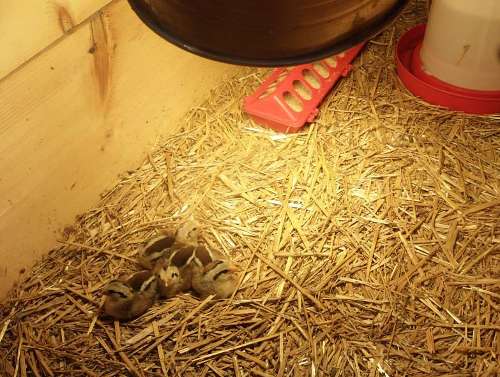
For details of what to put on the floor of a brooder see below.
The brooding area should be cleaned and disinfected and be ready with fresh bedding, food and water before the chicks arrive.
What equipment goes in a brooder?
The basic equipment list for a baby chicks brooder must include:
- The brood pen itself.
- At least one source of heat.
- Sand or bedding on the floor.
- A waterer the chicks can not drown in. 1 per 10 to 15 chicks
- A feeder. 1 per 10 to 15 chicks.
- Some source of entertainment.
- Optional extras like hanging a new cotton mop head in a corner to simulate a mother hen.
The brood space should allow chicks to indulge in natural behaviours like scratching and even dust bathing.
What is a brooder used for?
A brooder is used to keep young poultry like chicks, keets, ducklings or game-bird chicks warm and safe for the first 6 to 8 weeks of life.
It is a place where the chicks are safe, warm and have their needs for food , water and entertainment met.
A brooder house is a large commercial chick rearing shed where as many as 30,000 chicks can be raised or grown on at a time. They are often complex computer controlled environments.
For backyard keepers who raise a lot of poultry then it is likely to be a shed or garage given over to raising young birds.
Where should you put a brooder?
A brooder should be isolated from extremes of temperature and conditions and free from draughts. Ideally the ambient temperature should be 50F or 10C.
Keep the brooder in a location where you can see it easily and take notice of any potential problems. Make sure it is out of direct sunlight and is not going to get knocked over. Chicks make a lot of dust so if you have an asthma suffer in your house then take some precautions.
I put mine on my office desk in a cardboard box for the first few days and then move them to a garden shed after about a week or so. In cold weather I keep them indoor for a few extra days.
How long should chicks be kept in a brooder?
Chicks should be in the brooder for at least 6 weeks, longer if the weather is cold or wet. The temperature is dialled down as the chicks grow and they are given more space but they still need a warm spot to come back to.
Below: A large brooder setup with two of everything.
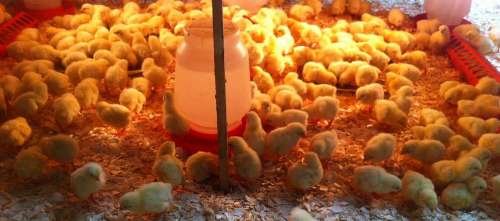
If the brooder has previously been used, it should be thoroughly cleaned, disinfected and allowed to air and in an ideal world, this would be done straight after the previous batch of chicks had moved out.
How do you make a brooder?
The average backyard chicken keepers has two options when it comes to brooding chicks, you can buy a brooder, but it is just as easy to make one using whatever is readily available.
You can make a brooder from any of these things:
- A large plastic tote or storage box. You can get these for a few dollars and they are easy to use and clean and can be stored easily.
- A large cardboard box or a ring of corrugated card that is normally used for packing parcels is ideal as a brooder for small numbers of chicks and can be changed quickly and regularly and is easy to dispose of.
- Plastic indoor rabbit cage. These are the type with a solid plastic base and a wire top. You can get some quite large ones and they can be suitable for up to 20 chicks.
- A child’s sandpit or paddling pool. Not the inflatable type but the style ones with a metal frame.
- A deep wooden drawer or crate. I once used an old wardrobe laid on it's back and brooder 40 guinea fowl keets successfully.
- A friend I have uses a and a large dog crate but they only raise a few at a time. This works well, being easy to clean and with the added security of the wire cage, but would need some extra draught protection in most environments.
Chicks don’t like draughts so the brooder must protect them from sudden changes of temperature, whilst allowing plenty of ventilation.
How big should a brooder be?
A brooder should have at least 1 square foot of floor space per chick as the grow quickly. You can sub divide it initially when they are very small and allow them more room as they grow.
If you are using plastic totes then you may need two at about three weeks onward. Make sure your intended brooder is roomy enough or can be made bigger as they grow. Another option is to split them into 2 boxes as they grow.
Below: This brooder is made from panels and can be extended by slotting more in as the chicks grow.
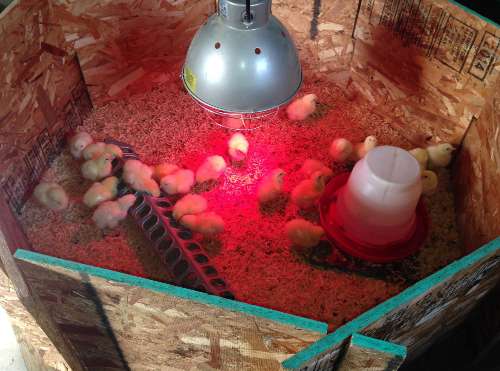
While all the chicks should be able to congregate under the warmth of the heat lamp, there must also be an unheated part of the brooder where they can eat, drink and exercise and get away from the heat if they need to.
Chicks vary in size, according to their parents – small chickens produce tiny chicks compared to some of the heavier breeds, and quail chicks are tiny. If the brooder looks too large at first, it can be partitioned with cardboard. This can later be removed to allow the chicks more space as they grow.
Chick brooder size depend on what breed and type of poultry you are raising and the number of chicks you will keep as well as you current weather conditions.
Japanese bantams are much smaller than Rhode Island Red chick for example, so the RIR will need at least twice as much room per chick.
Brooder precautions:
- Watch out for fire. Incandescent light bulbs will set fire to wood shavings or cardboard in no time at all. I use sand as a base as it will never burn if the bulb falls into the brooder.
- Draughts. Draughts will make chicks unthrifty and noisy and could lead to disease and death.
- Pets. Cats and dog could easily kill or injure chicks.
- Escapees. If chicks get out they may get lost or stuck behind cupboards or just die of the cold. Cover the brooder as they grow.
- Power failures. If you live in a prone area keep a battery backup or hot water bottles to get you through a few hours.
- Red coloured light is better than white.
See what is making your chicks sick or unwell.
The feathering may be retarded if they are kept in too warm conditions for to long.
Bear in mind too that wobbly little chicks grow surprisingly quickly into lively, energetic young birds, and will need space to move around freely as they develop. They also grow their wing feathers first and are capable of some surprisingly high escape attempts.
Overcrowding leads to fighting, disease and stress-related problems. All young birds are very vulnerable, and the brooder should be covered with wire-mesh to keep out inquisitive pets and prevent escapes. Some chicks try out their little wings after only a few days, and it’s amazing how high they can jump!
Which is the best bedding for the brooder floor?
Cover the floor of the brooder with a good layer of your choice of bedding. If your brooder is a cardboard box, lining the bottom with an extra piece of cardboard or some newspaper will help absorb excess moisture.
My first piece of advice to the first timers brooding in the house is to do it safe and sound.
I have switched to sharp builders sand for raising my chicks on. It’s like a mixture of sand and small gravel and the chicks seem to ignore it (food wise) for the most part and if they do eat it, it just has the same effect as grit in the diet. It also holds the warmth better and seems to be easier for the chicks to scratch around in or have a dust bath in.
Dust-extracted shavings make good bedding, although if the shavings are small then there is the danger of small chicks eating them until they work out where to find their feed. For a small hatch, a thick layer of paper towels can be used in the critical first few days, and this has the advantage of being very easy to keep clean.
Newspaper may seem a practical solution, but it is too slippery at first and can lead to chicks with splayed legs. However, newspaper can be useful for lining the bottom of the brooder, as long as it’s covered with plenty of bedding.
Peat moss in brooders is a good bedding but like everything there are compromises. Peat and sand produce quite a lot of dust and they have similar textures. Peat is a little like the compost you buy for plants and it does a great job controlling moisture and odour.
Just add a light layer of peat and then refresh as the birds age and to dry out any wet areas from the waterer or where they congregate around feeders. Peat is about twice as much to buy as pine shavings but you'll use about half as much and it makes a great addition to the compost pile when you are done with it.
Make sure you get everything ready in good time so that you can check it will all work properly and get it up and running for at least 12 hours to balance the temperatures and get a warm spot.
How do you heat chick brooders?
Brooders are heated with either incandescent light bulbs, electric hens, heating mats, ceramic heat bulbs or specialist gas brooders. A brood area need to have a reliable and even source of warmth that can be easily adjusted as the chicks require.
Below: 2 heat lamps heating a large plastic brooder.
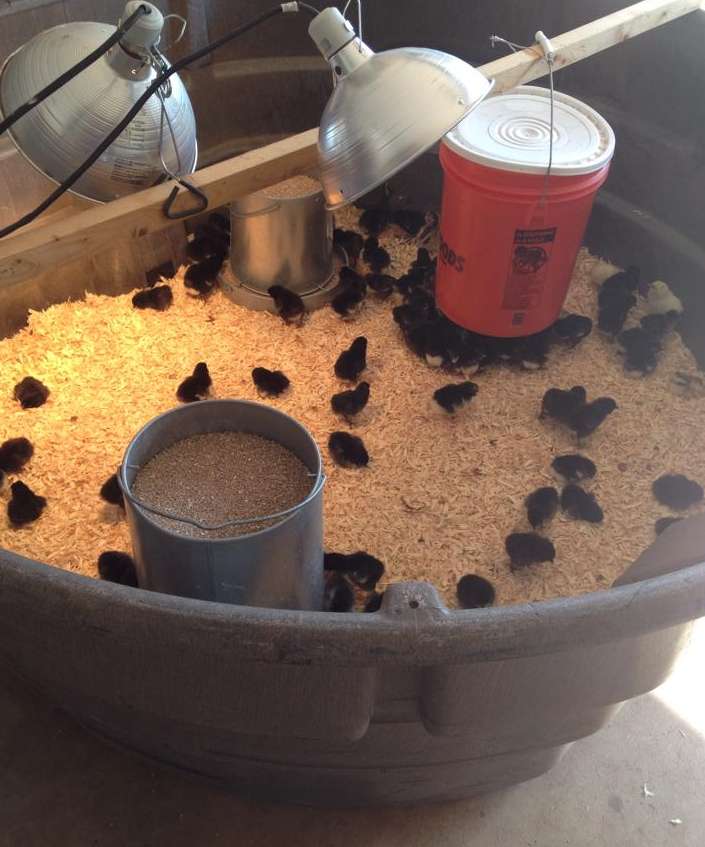
Chick brooder heaters come in various shapes and sizes and run in a few different ways. At one end of the scale are huge gas powered brooders that will keep thousands of chicks warm and at the other end of the spectrum there are the small heating pads or electric hens and light bulbs that will keep 10 or so chicks happy.
The heat source in a brooder can be:
- Incandescent light bulbs. These older style lamps give out as much heat as light and are very useful for brooding chicks. I have 2 desk lamps ans the height and position is easily adjustable.
- Electric hens. These are purpose made heat pads with adjustable height so you can brood different sized chicks and raise it up as they grow.
- Special infra red ceramic heat bulbs. You will need to provide some ligt as well if you use one of these.
- Large gas brooders for big setups.
How do you set up a brooder?
Chicks hatched artificially in an incubator have no mother hen to keep them warm. Without care and warmth they won’t survive, so you need to have a brooder ready before they start to hatch.
Steps to set up a brooder:
- Choose a location.
- Decide what container you will use.
- Choose a heat source. If you use bulbs use two or have a spare.
- Get feeder and waterer.
- Choose a bedding, I recommend sand.
- Buy your chicks crumb.
- Get it all together and up and running and test the temperature.
- Once you have a spot that is at least 38C (100F) Add the chicks.
Chicks will learn almost instantly where they feel comfortable and if you use lamps as a heat source you will see a ring of chicks under the light where the temperature is just right.
Chicks should be dry and fluffy before you remove them from the incubator and move them to the brooder. Chicks need to be dry and mobile before you remove them from the incubator and put them in the brooder.
For a few chicks being raised indoors, a good-sized cardboard box is often the easiest option, with the advantages of being both free and disposable. One drawback is that cardboard easily becomes soggy, especially when brooding waterfowl. Damp conditions are dangerous for young birds and can lead to illness like aspergillosis or brooder pneumonia amongst other conditions. It’s important to keep the brooder clean and change bedding frequently.
Set up the heat lamp or electric hen. A thermometer can be used to check the temperature is high enough in the warmest part of the brooder, although the chicks will soon tell you whether they are comfortable or not.
Cold chicks huddle together cheeping loudly, while too much heat causes them to move as far away from the lamp as possible. If they lay there panting, they are definitely too warm, and overheating can cause fatalities just as easily and quickly as cold or draughts.
Keep an eye on heat levels if the outside temperature is particularly high, remembering that things will cool down considerably at night.
Make sure the feeder and drinker waterer are cleaned and ready. Stock up with chicks crumb, high protein feed especially for chicks and wait for the eggs to hatch!
Make sure your intended brooder is roomy enough or can be made bigger as they grow. Another option is to split them into 2 boxes as they grow. While all the chicks should be able to congregate under the warmth of the heat lamp, there must also be an unheated part of the brooder where they can eat, drink and exercise and get away from the heat if they need to.
The feathering may be retarded if they are kept in too warm conditions for to long.
Little chicks grow surprisingly quickly into lively, energetic young birds, and will need space to move around freely as they develop. They also grow their wing feathers first and are capable of some surprisingly high escape attempts.
Overcrowding leads to disease and stress-related problems. All young birds are very vulnerable, and the brooder should be covered with wire-mesh to keep out inquisitive pets and prevent escapes. Some chicks try out their little wings after only a few days, and it’s amazing how high they can jump!
Food for baby chicks in the brooder:
Chick crumbs are a complete food, although I add chick-sized grit too. I give mine access to greens from a very young age, mainly in the form of young spinach leaves.
Below: A day old chick tucking into the crumb.

Crumb can vary in quality and buying the cheapest can be poor economy and the cheap ones tend to be very dusty with nutritional deficiencies and the chicks may find them difficult to eat.
Can you brood chicks outside?
The brooder could also be placed in a suitable outbuilding as long as there is power for the heat-lamp and lighting or a good source of natural light. This could even be a garage or the coop where the young birds will eventually live.
You should never try to brood chicks in the open air.
As well as being free from draughts, the building must be completely rat-proof. Rats will be attracted by the smell and will kill the chicks if they gain access. As rats are very good at getting into places they are not required, cover wooden floors with wire-mesh or a double layer of fine mesh.
